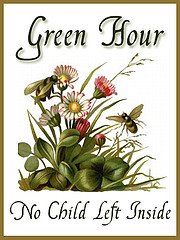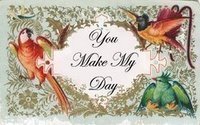Earlier this week I was with my friend the Yummy Mummy. We were talking, as we usually do, about mothering and children. She commented that the common thread in all parenting books is to treat your child with love and kindness, and provide them with a stable, secure environment. She also commented that she personally couldn’t get that excited about things like wooden toys and not using playpens, and that surely children wouldn’t be any worse off for playing with lots of cheap plastic toys.
I have to say I’d never really looked at it that way. I was so convinced of the inherent superiority of what I think of as ‘real’ toys – wooden, open-ended, natural, old-fashioned toys that I had never challenged myself as to why.
On reflection, I don’t necessarily believe that Munchkin will somehow be ‘advantaged’ by having wooden toys, or spending as much time as possible outside, or going to a Steiner playgroup. I don’t think that she will be smarter or happier than other children who play with Barbies (urggh) or Fisher Price toys with lots of batteries and whizzy bits.
But yet, I am very passionate about what Munchkin plays with, as those of you who read often will know. I believe that simple toys encourage Munchkin to use her imagination. I believe that avoiding ‘licensed’ toys will keep some of our pervasive consumer culture out of her childhood. I believe that natural materials means the toys are a bit safer for her to chew on. I know that natural toys, made either in a fair-trade situation or by independent crafts-people in first world nations, are better for the environment and better for the world.
So I choose real toys, not because I think it makes me a better parent, but because of my personal values. Some of the values that I hold very dear are walking gently on the earth, respecting all human beings, and a belief in the infinite nature of human potential. These values are expressed in everything I do, and in particular they are expressed every time I spend, or don’t spend, money. For me principles of fair trade, environmental sustainability and honouring craftsmanship are important considerations in every purchase I make.
This isn’t to say that I only buy fair trade, organic, eco-friendly products – I don’t. Financial realities and day to day efficiency often come first … but I try to strike a balance. I certainly hope that Munchkin’s childhood will teach her these values. I do hope that she will have a wonderful childhood – but it’s a reflection of my ‘ideal’ of a wonderful childhood.
But I have to say, I’ve realized that as much as I care about this I would hate to be a zealot. I don’t want to ‘take a stand’ when Grandparents buy her plastic battery powered rubbish – I want to teach her gratitude and respect too. I know some parents who have had major family falling outs over the ‘toy’ issue, and I would feel so sad if I became so obsessed with this issue that I let my relationships suffer for it.
Its easy in natural parenting circles to get caught up in the dogma. Its easy to feel that our way is somehow superior, and that all parents should be like us. By making the personal political we can become very judgmental of others. Its one of the reasons that I am so glad to have friends whose values are a bit different to mine, and who aren’t afraid to say so. The moral high-ground is, after all, a very lonely place to be.
Raw Cauliflower Salad
15 years ago




